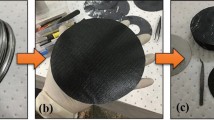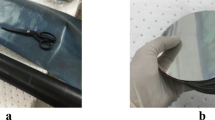Abstract
Although fiber metal laminates (FMLs) were invented a few decades ago, large-scale manufacturing, especially the forming process of small and complex-shaped products, has not been matured yet. The forming difficulty comes with the limited strain rate of the fiber layers compared to the metallic layers. As a result, the conventional approaches to form FML parts are not very suitable. Understanding the material behavior during the forming process is critical to find a new technique for relatively intricate and smaller FML parts. The blank holder gap (BHG) is one of the effective parameters to control the material flow in the deep drawing process, but in the case of the FMLs, the situation is completely different due to the laminate constituent. The compression of the fiberglass and thermo-plastique resin to the blank holder force (BHF) is not the same as the metals. The resin acts like a rubber, which decreases the thickness of the laminate and affects the friction between the laminate layers, especially when forming semi-cured laminates, which makes it hard to define an ideal BHF. This paper presents the results of numerical and experimental investigation of the effect of the BHG on the hydromechanical deep drawing (HDD) of a cylindrical cup made with 2/1 Glare sheets. It is found that the optimized BHF and cavity pressure (CP) with a BHG of 1.1 mm, smaller than the laminate’s initial thickness of 1.2 mm, resulted in a good part with a significant depth improvement of 35 mm. Results also exhibited that FML parts manufactured by considering the BHG can enhance its applications and lead to a reduction of time and effort spent in mass production.













Similar content being viewed by others
References
Vogelesang LB, Vlot A (2000) Development of fiber metal laminates for advanced aerospace structures. J Mater Process Technol 103:1–5. https://doi.org/10.1016/S0924-0136(00)00411-8
Logesh K, Bupesh Raja VK (2019) Evaluation of mechanical properties of Mg-Al layered double hydroxide as a filler in epoxy-based FML composites. Int J Adv Manuf Technol 104:3267–3285. https://doi.org/10.1007/s00170-018-1692-8
Roth S, Stoll M, Weidenmann KA, Coutandin S, Fleischer J (2019) A new process route for the manufacturing of highly formed fiber-metal-laminates with elastomer interlayers (FMEL). Int J Adv Manuf Technol 104:1293–1301. https://doi.org/10.1007/s00170-019-04103-4
De Jong TW (2004) Forming of laminates. ISBN 90-407-2506-3, Delft University Press, pp 2
Asundi A, Choi AYN (1997) Fiber metal laminates: an advanced material for future aircraft. J Mater Process Technol 63:384–394. https://doi.org/10.1016/s0924-0136(96)02652-0
Ad V, Gunnink JW (2001) Fibre metal laminates: an introduction. Kluwer Academic Publishers, Dordrecht, pp 12–39, 20. https://doi.org/10.1007/978-94-010-0995-9
Hassan M, Othman A, Kamaruddin S (2017) A review on the manufacturing defects of complex-shaped laminate in aircraft composite structures. Int J Adv Manuf Technol 91:4081–4094. https://doi.org/10.1007/s00170-017-0096-5
Park SY, Choi WJ, Choi HS (2010) A comparative study on the properties of Glare laminates cured by autoclave and autoclave consolidation followed by oven post-curing. Int J Adv Manuf Technol 49:5–8. https://doi.org/10.1299/jamdsm.6.42010.1007/s00170-009-2408-x
Sherkatghanad E, Lang L, Liu S, Wang Y (2018) Innovative approach to mass production of fiber metal laminate sheets. J Mater Manuf Processes 33:552–563. https://doi.org/10.1080/10426914.2017.1364864
Mosse L, Compston P, Cantwell WJ, Cardew-Hall M, Kalyanasundaram S (2006) Stamp forming of polypropylene-based fibre-metal laminates: the effect of process variables on formability. J Mater Process Technol 172:163–168. https://doi.org/10.1016/j.jmatprotec.2005.09.002
Seyedkashi SMH, Cho JR, Lee SH, Moon YH (2018) Feasibility of underwater laser forming of laminated metal composites. J Mater Manuf Process 33(5):546–551. https://doi.org/10.1080/10426914.2017.1376075
Liu W, An L, Yuan S (2017) Enhancement on deformation uniformity of double curvature shell by hydroforming process and curved blank-holder surface. Int J Adv Manuf Technol 92:1913–1922. https://doi.org/10.1007/s00170-017-0301-6
Sadegh-yazdi M, Bakhshi-Jooybari M, Shakeri M, Gorji H, Khademi M (2018) Optimization of pressure paths in hydrodynamic deep drawing assisted by radial pressure with inward flowing liquid using a hybrid method. Int J Adv Manuf Technol 97:2587–2601. https://doi.org/10.1007/s00170-018-2023-9
Hasan GN, Mahdi G, Mehdi FN (2017) Experimental and numerical study on formability in tube bulging: a comparison between hydroforming and rubber pad forming. J Mater Manuf Processes 32(12):1353–1359. https://doi.org/10.1080/10426914.2016.1257126
Dewang Y, Panthi SK, Hora MS (2019) Binder force effect on stretch flange forming of aluminum alloy. J Mater Manuf Process 34(13):1516–1527. https://doi.org/10.1080/10426914.2019.1655154
Liu S, Lang L, Guan S (2019) An investigation into the formability and processes of Glare materials using hydro-bulging test. Int J Precis Eng Manuf 20:121–128. https://doi.org/10.1007/s12541-019-00046-8
Kusumi K, Nomura N, Yamamoto S, Nakata M, Abe M, Suehiro M (2014) Improvement of cylindrical deep drawability in hot stamping. Proc Eng 81:1719–1724. https://doi.org/10.1299/jamdsm.6.42010.1016/j.proeng.2014.10.220
Gavss M, Izciler M (2007) Effect of blank holder gap on deep drawing of square cups. J Mater Desing Reigate 28:1641–1646. https://doi.org/10.1299/jamdsm.6.42010.1016/j.matdes.2006.03.024
Lang L, Danckert J, Nielsen KB (2004) Investigation into hydrodynamic deep drawing assisted by radial pressure: part I. Experimental observations of the forming process of aluminum alloy. J Mater Proc Tech 148:119–131. https://doi.org/10.1299/jamdsm.6.42010.1016/j.jmatprotec.2004.01.053
Srirat J, Yamazaki K, Kitayama S (2017) Optimization of segmented blank holder shape and its variable blank holder gap in deep drawing process, J Advanced Mechanical Design, Systems, and Manufacturing. 6:420–431. https://doi.org/10.1299/jamdsm.6.420
Wifi A, Mosallam A (2007) Some aspects of blank-holder force schemes in deep drawing process. J Achiev Mater Manuf Eng 24
Huaibao W, Welli X, Zhongqin L, Yuying Y, Wang Z (2002) Stamping and stamping simulation with a blank holder gap. J Mater Proc Tech 120:62–67. https://doi.org/10.1299/jamdsm.6.42010.1016/S0924-0136(01)01112-8
Venkat Reddy R, Janardhan Reddy TA (2013) Effect of various parameters on wrinkling with imperfections in deep drawing of cylindrical cup. Int. J. Emerging Technol Adv Eng ISSN 2250-2459
Harith M (2018) The influence of blankholder gap on deep drawing process using finite element method. Int J Mech Eng Technol 9(13):1510–1518
Abedrabbo N, Zampaloni M, Pourboghrat F (2015) Wrinkling control in aluminum sheet hydro-forming. Int J Mech Sci 47:333–358. https://doi.org/10.1016/j.ijmecsci.2005.02.003
Hashemi A, Hoseinpour Gollo M, Seyedkashi SMH (2017) Study of Al/St laminated sheet and constituent layers in radial pressure-assisted hydrodynamic deep drawing. J Mater Manuf Process 32(1):54–61. https://doi.org/10.1080/10426914.2015.1127947
Zafar R, Lihui L, Rongjing Z, Shaohua W (2014) Formability analysis of fiber metal laminates using rubber sheet and forming techniques. Inter, Bhurban Conference on Applied Sciences and Technology 44-47. https://doi.org/10.1299/jamdsm.6.42010.1109/IBCAST.2014.6778118
Zafar R, Lihui L, Rongjing Z (2015) Analysis of hydro-mechanical deep drawing and the effects of cavity pressure on quality of simultaneously formed three-layer Al alloy parts. IntJ Adv Manuf Technol 80:2117–2128. https://doi.org/10.1007/s00170-015-7142-y
Pal Singh C, Agnihotri G (2015) Study of deep drawing process parameters: a review. Int J Sci Res Publ (IJSRP) 5(2)
Ziaeipoor H, Moosavi H (2013) An investigation of wrinkling and thinning in hydroforming deep drawing process with hemispherical punch. Int J Mech Syst Eng 3:89–96
Park SY, Choi WJ, Choi HS (2010) A comparative study on the properties of glare laminates cured by autoclave and autoclave consolidation followed by oven postcuring. Int J Adv Manuf Technol 49:605–613. https://doi.org/10.1007/s00170-009-2408-x
Botelho E, Silva RA, Pardini LC, Rezende MC (2006) A review on the development and properties of continuous fiber/epoxy/aluminum hybrid composites for aircraft structures. Mater Res 9(3):247–256. https://doi.org/10.1590/S1516-14392006000300002
Kumar RU, Reddy PR, SitaRamaraju AV (2012) Effect of blank radius on radial stresses in hydrofoorming deep drawing process. IPASJ, Int J Mech Eng (IIJME)
Taguchi G, Konishi S (1987) Taguchi methods, orthogonal arrays, and linear graphs, tools for quality engineering, vol 1987. American Supplier Institute, Dearborn, pp 35–38
Funding
This work was supported by the National Science Foundation of China under grant 51675029 and the Science and Technology Project of Sichuan Province under grant 2019YFSY0034.
Author information
Authors and Affiliations
Corresponding authors
Ethics declarations
Conflict of interest
The authors declare that they have no conflict of interest.
Additional information
Publisher’s note
Springer Nature remains neutral with regard to jurisdictional claims in published maps and institutional affiliations.
Rights and permissions
About this article
Cite this article
Blala, H., Lang, L., Li, L. et al. Investigation on the effect of blank holder gap in the hydroforming of cylindrical cups, made of fiber metal laminate. Int J Adv Manuf Technol 108, 2727–2740 (2020). https://doi.org/10.1007/s00170-020-05467-8
Received:
Accepted:
Published:
Issue Date:
DOI: https://doi.org/10.1007/s00170-020-05467-8




